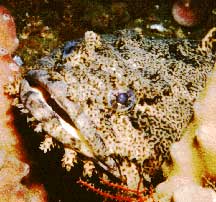| Oyster toadfish | |
|---|---|

| |
| Scientific classification | |
| Domain: | Eukaryota |
| Kingdom: | Animalia |
| Phylum: | Chordata |
| Class: | Actinopterygii |
| Order: | Batrachoidiformes |
| Family: | Batrachoididae |
| Genus: | Opsanus |
| Species: | O. tau
|
| Binomial name | |
| Opsanus tau (Linnaeus, 1766)
| |
| Synonyms[2] | |
| |
The oyster toadfish (Opsanus tau), also known as the oyster toad, ugly toad, oyster cracker, oyster catcher, and bar dog, is a Northwest Atlantic species of fish of the family Batrachoididae. The maximum length of this toadfish is 43.2 cm (17 in), but they infrequently surpass 38 cm (15 in). The world record size for this species is 19.2 inches which is 48.76 cm. They are generally yellowish with a pattern of brown oblique bars. The species can live in poor conditions and needs little food to live. They can be found near the shore from Maine to Florida.
In 1998, NASA sent the oyster toadfish into space to investigate the effects of microgravity on the development of otolithic organs. The study found little difference between terrestrial development and those in space.
- ^ Collette, B.B. (2015). "Opsanus tau". IUCN Red List of Threatened Species. 2015: e.T16441738A16509767. doi:10.2305/IUCN.UK.2015-4.RLTS.T16441738A16509767.en. Retrieved November 20, 2021.
- ^ Froese, Rainer; Pauly, Daniel (eds.). "Opsanus tau". FishBase. February 2018 version.
